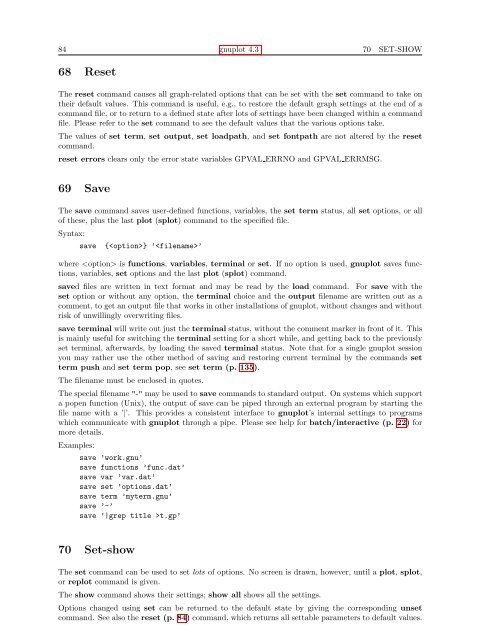gnuplot documentation
gnuplot documentation
gnuplot documentation
You also want an ePaper? Increase the reach of your titles
YUMPU automatically turns print PDFs into web optimized ePapers that Google loves.
84 <strong>gnuplot</strong> 4.3 70 SET-SHOW<br />
68 Reset<br />
The reset command causes all graph-related options that can be set with the set command to take on<br />
their default values. This command is useful, e.g., to restore the default graph settings at the end of a<br />
command file, or to return to a defined state after lots of settings have been changed within a command<br />
file. Please refer to the set command to see the default values that the various options take.<br />
The values of set term, set output, set loadpath, and set fontpath are not altered by the reset<br />
command.<br />
reset errors clears only the error state variables GPVAL ERRNO and GPVAL ERRMSG.<br />
69 Save<br />
The save command saves user-defined functions, variables, the set term status, all set options, or all<br />
of these, plus the last plot (splot) command to the specified file.<br />
Syntax:<br />
save<br />
{} ’’<br />
where is functions, variables, terminal or set. If no option is used, <strong>gnuplot</strong> saves functions,<br />
variables, set options and the last plot (splot) command.<br />
saved files are written in text format and may be read by the load command. For save with the<br />
set option or without any option, the terminal choice and the output filename are written out as a<br />
comment, to get an output file that works in other installations of <strong>gnuplot</strong>, without changes and without<br />
risk of unwillingly overwriting files.<br />
save terminal will write out just the terminal status, without the comment marker in front of it. This<br />
is mainly useful for switching the terminal setting for a short while, and getting back to the previously<br />
set terminal, afterwards, by loading the saved terminal status. Note that for a single <strong>gnuplot</strong> session<br />
you may rather use the other method of saving and restoring current terminal by the commands set<br />
term push and set term pop, see set term (p. 135).<br />
The filename must be enclosed in quotes.<br />
The special filename "-" may be used to save commands to standard output. On systems which support<br />
a popen function (Unix), the output of save can be piped through an external program by starting the<br />
file name with a ’|’. This provides a consistent interface to <strong>gnuplot</strong>’s internal settings to programs<br />
which communicate with <strong>gnuplot</strong> through a pipe. Please see help for batch/interactive (p. 22) for<br />
more details.<br />
Examples:<br />
save ’work.gnu’<br />
save functions ’func.dat’<br />
save var ’var.dat’<br />
save set ’options.dat’<br />
save term ’myterm.gnu’<br />
save ’-’<br />
save ’|grep title >t.gp’<br />
70 Set-show<br />
The set command can be used to set lots of options. No screen is drawn, however, until a plot, splot,<br />
or replot command is given.<br />
The show command shows their settings; show all shows all the settings.<br />
Options changed using set can be returned to the default state by giving the corresponding unset<br />
command. See also the reset (p. 84) command, which returns all settable parameters to default values.

















